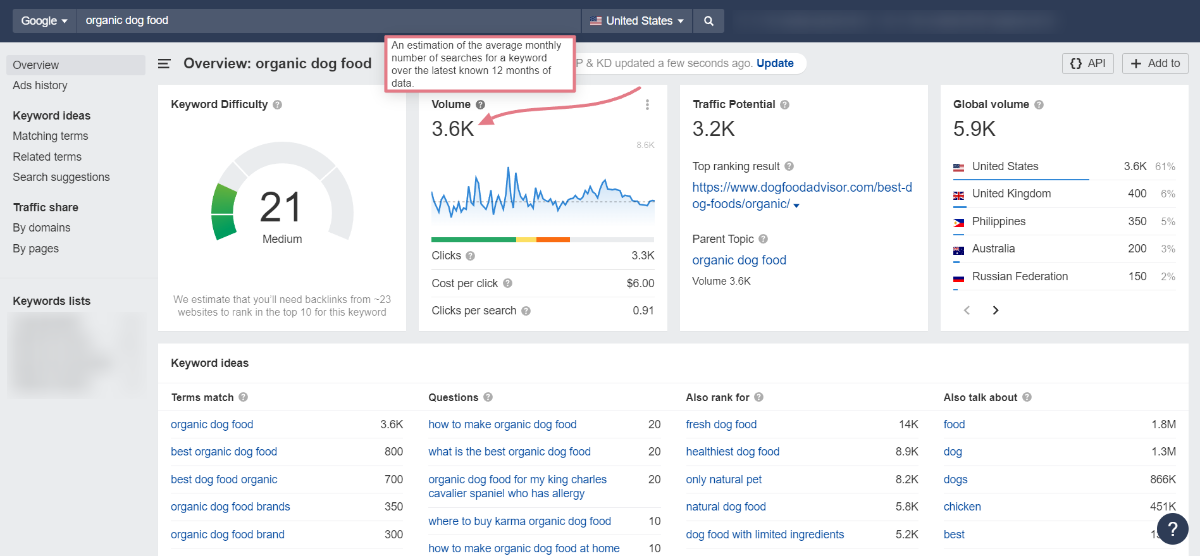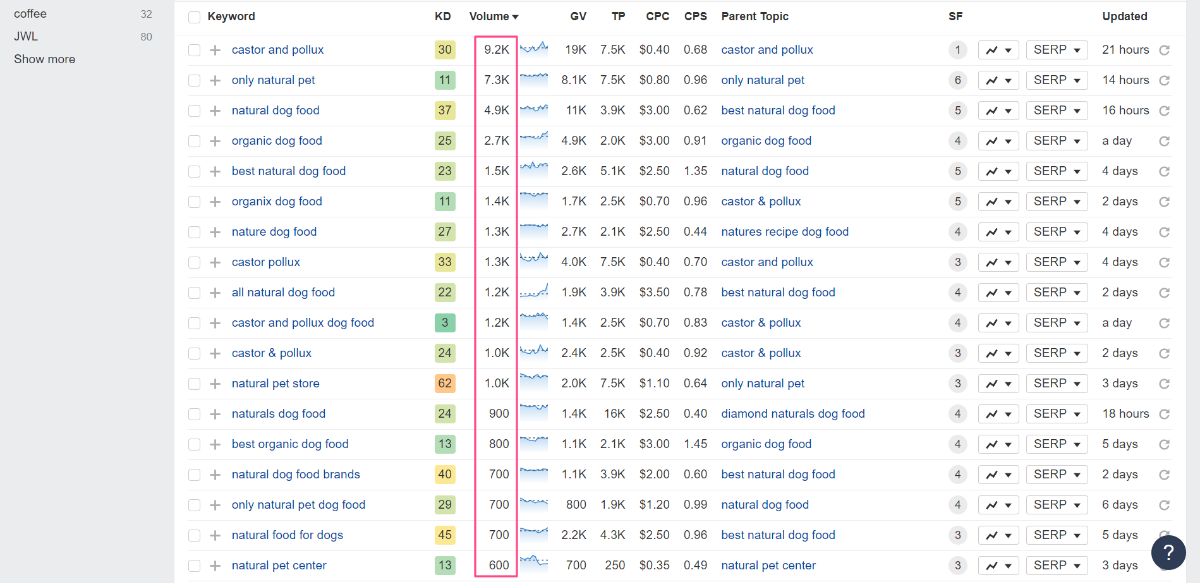What Is Search Volume? An Exploration of SEO’s Core Metric

Hand off the toughest tasks in SEO, PPC, and content without compromising quality
Explore ServicesWith developments in artificial intelligence (AI) and algorithm updates constantly shifting the goalposts, the world of search engine optimization (SEO) is evolving faster than ever.
One metric consistently holds a place of permanence, though: search volume. But what is search volume? And how can you leverage it in your SEO or digital marketing strategy?
That’s exactly what we aim to tackle in this guide. Aside from defining exactly what search volume is, we’ll also explore
- the importance of search volume,
- which SEO tools are best to determine search volume,
- and unravel the mystery of what constitutes a “good” keyword search volume.
What is Search Volume in SEO?
You could think of search volume like this: the connection between search volume and keywords is a pulse check of popularity. Intuitively, the higher the search volume, the more search engine users are interested in the topic or product.
Let’s take the keyword “organic dog food,” for example. Per the data pulled from Ahrefs’ SEO tool, this keyword presently records an average monthly search volume of 3,600 in the US. This figure gives you a rough idea of the level of interest and demand that exists for organic dog food products.

Learn more: SEO glossary 250+ terms explained.
Why is Search Volume Important?
Understanding search volume helps webmasters like yourself decipher user behavior and their search intent. As we just touched on, keywords with a high search volume indicate widespread interest in a particular topic. So, if you possess the ability to identify high-volume keywords, you’ll be able to create targeted content that has the potential to capture a wide audience’s attention and, theoretically, attract a high number of visitors to your website.
The more keywords in your content, the better, then, right? Nope.
Don’t make the mistake of simply stuffing your content with high-volume keywords. This won’t necessarily improve your ranking. In fact, this tactic is viewed by Google as black hat, a manipulative practice they actively penalize.
Instead, your content should be high-quality, relevant, and organically integrate these keywords.
As Google puts it in their notes on the recent Helpful Content Update, “…create content for people, not for search engines.” Something they call “people-first content.” In other words, you should create content that strikes a balance between targeting popular keywords, those unique and attractive to your niche audience, while also doing it in a natural and organic manner.
In this Tweet, Google’s John Mueller adds that you should focus on content “awesomeness” over getting too carried away with aligning with ranking factor best practices.
Search volume’s influence also extends to conversions. Just keep in mind that it’s a nuanced relationship. Sure, while keywords with high search volume can draw visitors, actual conversions depend on various factors like content relevance, product or service quality, and a user’s overall experience.
How Search Volume Works
You’ll find that high search volume keywords are typically broad in nature, generic, and short-tail—something like “shoes” or “smartphones” fall into this category. Due to their generic and broad appeal, these keywords attract searches from a large user base and intensify the competition.
On the flip side, low search volume keywords are typically more specific, niche-oriented, or long-tail, akin to phrases like “vegan leather shoes in San Francisco.” Sure, while these keywords may draw fewer searches, they usually face less competition. This niche appeal often results in more targeted and potentially high-converting traffic directed to your website.
The crème de la crème of organic traffic.
Something else to keep in mind is that search volume is susceptible to seasonal trends. On one hand, you’ve got “evergreen keywords,” meaning their search volume remains relatively steady throughout the year. As you can imagine, “weather” or “news” are consistently sought-after topics, no matter the time of year.
On the other hand, seasonal keywords see a surge in search volume at specific times throughout the year. “Christmas gift ideas” peak in the US during December, while “swimwear” sees a surge during the summer months. Understanding these fluctuations helps you optimize your SEO strategy to tap into these peaks, keeping your content relevant and timely for your audience, depending on where they are located in the world.
What Is a Good Keyword Search Volume?

What constitutes a “good” keyword search volume depends largely on your specific business context, the strength or authority of your website, your digital marketing needs, and your overall goals.
For instance, a small business that operates in a local market might see significant benefits from targeting locally focused keywords that only attract a few hundred searches per month. While an eCommerce giant that operates on a global scale will likely snub their nose at low-volume keywords and, instead, opt to target keywords that see tens of thousands or even hundreds of thousands of searches each month.
Learn more: how to do local keyword research.
Balancing Volume with Competition: Finding the Sweet Spot
The art of keyword strategy involves much more than simply hunting down high-volume keywords. It’s a balancing act between search volume and competition. Given that high search volume can potentially attract substantial site traffic, it often correlates with intense competition.
This makes ranking for high-volume keywords a herculean task, especially for newer or smaller websites.
With these potential challenges in mind, particularly for small domains or local businesses, you’ll want to find the sweet spot: keywords with enough search volume to drive enough traffic to make sense in terms of return on investment (ROI) but not so much that they are overly competitive.
The Role of Long-Tail Keywords in Search Volume
Targeting long-tail keywords may also come into play when finding the sweet spot. These are longer, more specific phrases that, while individually they might have lower search volumes, can collectively attract significant traffic.
Long-tail keywords also often indicate a higher intent to purchase or convert, making them incredibly valuable. Remember, a keyword like “shoes” may have a high search volume, but it’ll be competitive. On the other hand, “men’s running shoes for flat feet” is a long-tail keyword. It may have a lower search volume, but it targets a specific, motivated audience.
Search Volume Variance
One last thing to keep in mind: when you start using different SEO tools to investigate search volume, you may encounter discrepancies in reported data, with search volumes exhibiting a broad spectrum that can range from a mere handful to several thousand.
It’s important, then, to understand that these numbers are not absolute. As mentioned in this Reddit post, the OP asked the question: “How accurate is SEMrush keyword volume?” SEMrush highlights that each tool estimates the search volume based on a variety of metrics, and each calculates these differently.

So, what you’re getting are approximations rather than exact figures. As SEMrush points out, it’s akin to comparing apples to oranges if you look at similar metrics across tools. That’s why SEMrush, along with other SEO experts, suggests picking one tool, sticking to it, and using that to benchmark others.
Conclusion
As you can see, a solid understanding of search volume will inform your SEO strategies, something that’s invaluable to decide 1) which keywords to target, 2) how to balance competition with opportunity, and 3) when to incorporate long-tail keywords.
Just remember: no journey should be undertaken alone. Our team of SEO experts will assist in crafting an effective SEO content strategy tailored to your business’s specific needs.
🚀 Discover how Loganix’s keyword research services will help you today! 🚀
Hand off the toughest tasks in SEO, PPC, and content without compromising quality
Explore ServicesWritten by Brody Hall on October 31, 2023
Content Marketer and Writer at Loganix. Deeply passionate about creating and curating content that truly resonates with our audience. Always striving to deliver powerful insights that both empower and educate. Flying the Loganix flag high from Down Under on the Sunshine Coast, Australia.





